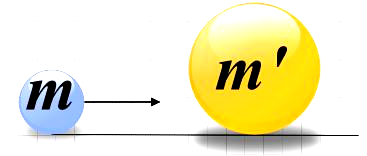Answer
414.6k+ views
Hint: Try to imagine the situation in your mind. You may have noticed that, when a smaller body hits a larger body at rest, the larger body gains velocity and starts moving, but the smaller body moves faster than before. This may make you wonder that force acting on it more, but that’s not the case. Recall Newton’s laws of motion to find out the answer.
Complete answer:

In the question, we are given two bodies of unequal masses. The small body here is hitting the very large body we are asked to determine the magnitude and direction of the forces acting on both these bodies.
The interaction happening between these two bodies is called collision. Collision basically is the interaction between two objects that had made contact with each other. Also, just like in the case of any other interactions, there exists two forces acting on the two bodies as the result of this collision.
Now let us recall Newton’s third law of motion. It states that ‘every action has an equal and opposite reaction.’ So, here in the given case, both objects experience forces that are equal in magnitude and opposite in direction which further causes gain in momentum in one of the bodies and loss of momentum in the other.
However, the two bodies may gain and lose velocity due to the collision. As a result of this collision, the lighter body gets accelerated more and hence moves faster than the other after the collision. This is because, the acceleration, by Newton’s second law depends on both the mass of the body as well as force acting on the body, that is,
$a=\dfrac{F}{m}$
Therefore, the least massive the body is, the more accelerated it gets.
So by Newton’s third law of motion we could say that the forces acting on both the bodies are equal in magnitude but opposite in direction.
So, the correct answer is “Option C”.
Note:
However, the linear momentum is conserved in this collision by the law of conservation of momentum. Therefore,
$mv=-m'v'$
The negative sign here indicates that, one body gains momentum and the other loses it. That is, the momentum gained by one body is equal to the momentum lost by the other.
Complete answer:

In the question, we are given two bodies of unequal masses. The small body here is hitting the very large body we are asked to determine the magnitude and direction of the forces acting on both these bodies.
The interaction happening between these two bodies is called collision. Collision basically is the interaction between two objects that had made contact with each other. Also, just like in the case of any other interactions, there exists two forces acting on the two bodies as the result of this collision.
Now let us recall Newton’s third law of motion. It states that ‘every action has an equal and opposite reaction.’ So, here in the given case, both objects experience forces that are equal in magnitude and opposite in direction which further causes gain in momentum in one of the bodies and loss of momentum in the other.
However, the two bodies may gain and lose velocity due to the collision. As a result of this collision, the lighter body gets accelerated more and hence moves faster than the other after the collision. This is because, the acceleration, by Newton’s second law depends on both the mass of the body as well as force acting on the body, that is,
$a=\dfrac{F}{m}$
Therefore, the least massive the body is, the more accelerated it gets.
So by Newton’s third law of motion we could say that the forces acting on both the bodies are equal in magnitude but opposite in direction.
So, the correct answer is “Option C”.
Note:
However, the linear momentum is conserved in this collision by the law of conservation of momentum. Therefore,
$mv=-m'v'$
The negative sign here indicates that, one body gains momentum and the other loses it. That is, the momentum gained by one body is equal to the momentum lost by the other.
Recently Updated Pages
How many sigma and pi bonds are present in HCequiv class 11 chemistry CBSE

Why Are Noble Gases NonReactive class 11 chemistry CBSE

Let X and Y be the sets of all positive divisors of class 11 maths CBSE

Let x and y be 2 real numbers which satisfy the equations class 11 maths CBSE

Let x 4log 2sqrt 9k 1 + 7 and y dfrac132log 2sqrt5 class 11 maths CBSE

Let x22ax+b20 and x22bx+a20 be two equations Then the class 11 maths CBSE

Trending doubts
Fill the blanks with the suitable prepositions 1 The class 9 english CBSE

At which age domestication of animals started A Neolithic class 11 social science CBSE

Which are the Top 10 Largest Countries of the World?

Give 10 examples for herbs , shrubs , climbers , creepers

Difference between Prokaryotic cell and Eukaryotic class 11 biology CBSE

Difference Between Plant Cell and Animal Cell

Write a letter to the principal requesting him to grant class 10 english CBSE

Change the following sentences into negative and interrogative class 10 english CBSE

Fill in the blanks A 1 lakh ten thousand B 1 million class 9 maths CBSE



